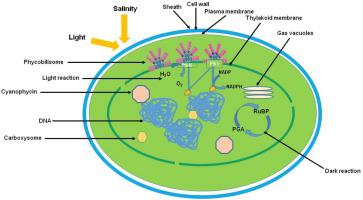Environmental and Experimental Botany ( IF 4.5 ) Pub Date : 2021-08-14 , DOI: 10.1016/j.envexpbot.2021.104620 Vinod Kumar 1 , Soumila Mondal 1 , Anjali Gupta 1 , Pankaj K. Maurya 1 , Rajeshwar P. Sinha 2 , Donat-P. Häder 3 , Shailendra P. Singh 1

|
Cyanobacteria are subjected to a dynamic light environment in their natural habitat or artificial cultivation system. The fluctuating light environment is associated with increased salinity stress due to the evaporation of the growth medium. Therefore, it is important to understand the physiology of the organisms under a dynamic environment of light and salinity which together affect the fitness and overall performance of the organism. We studied the growth behavior and other physiological parameters of Synechococcus elongatus PCC 7942 in the presence of different NaCl concentrations (0, 50, 100 and 200 mM) and light conditions such as low PAR (LPAR), high PAR (HPAR) and PAR + UVR using diurnal and continuous photoperiods. We also investigated the ability of S. elongatus PCC 7942 to biosynthesize UV-absorbing mycosporine-like amino acids (MAAs) and conducted genetic and comparative protein structure analyses to better understand its biosynthesis. Results obtained suggest that the impact of salinity stress caused by NaCl on growth behavior and physiological parameters such as photosynthetic pigments, the effective quantum yield of PSII and oxidative stress is dependent on the light environment. These parameters were affected differently by the quality and quantity of light and photoperiods, and the negative effect of salinity was alleviated by a high light environment. S. elongatus PCC 7942 does not biosynthesize MAAs due to the absence of MAAs biosynthesizing genes cluster in its genome. Results from genomic and comparative protein structure analyses suggested that DDGS and DHQS enzymes are different and DDGS but not DHQS is required for MAAs biosynthesis. Understanding the light-dependent impact of salinity stress may help in developing strategies for outdoor cultivation of cyanobacteria for bioenergy and valuable chemicals production by balancing absorbed and utilized radiant energy.
中文翻译:

盐度对细长聚球藻 PCC 7942 生态生理学的光依赖性影响:吸收紫外线的类菌孢素氨基酸 (MAA) 生物合成的遗传和比较蛋白质结构分析
蓝藻在其自然栖息地或人工栽培系统中受到动态光环境的影响。由于生长培养基的蒸发,波动的光环境与增加的盐度压力有关。因此,了解生物体在光和盐度的动态环境下的生理机能非常重要,光和盐度共同影响生物体的健康和整体表现。我们研究了细长聚球藻PCC 7942 在不同 NaCl 浓度(0、50、100 和 200 mM)和光照条件(如低 PAR (LPAR)、高 PAR (HPAR) 和 PAR +)的生长行为和其他生理参数UVR 使用昼夜和连续光周期。我们还研究了S. elongatus的能力PCC 7942 用于生物合成吸收紫外线的类菌孢素氨基酸 (MAA),并进行遗传和比较蛋白质结构分析以更好地了解其生物合成。获得的结果表明,NaCl 引起的盐度胁迫对光合色素、PSII 的有效量子产率和氧化胁迫等生长行为和生理参数的影响取决于光环境。这些参数受光的质量和数量和光周期的影响不同,高光环境减轻了盐度的负面影响。S. elongatusPCC 7942 不生物合成 MAA,因为其基因组中不存在 MAA 生物合成基因簇。基因组和比较蛋白质结构分析的结果表明 DDGS 和 DHQS 酶是不同的,MAA 生物合成需要 DDGS 而不是 DHQS。了解盐度胁迫的光依赖影响可能有助于通过平衡吸收和利用的辐射能来制定用于生物能源和有价值化学品生产的蓝藻户外培养策略。











































 京公网安备 11010802027423号
京公网安备 11010802027423号